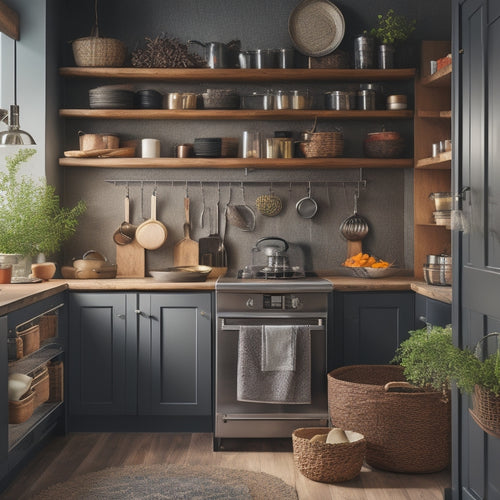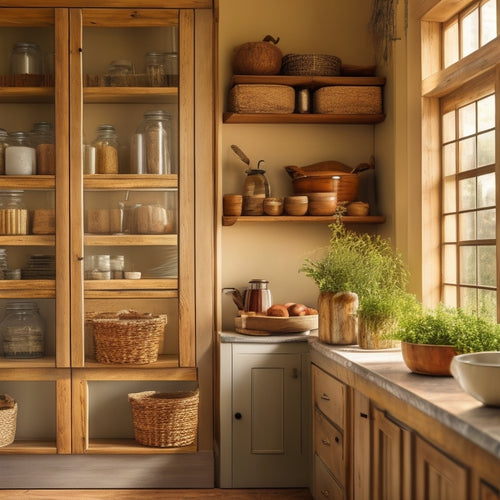
10 Essential Senior-Friendly Kitchen Design Principles
Share
You're designing a senior-friendly kitchen that's all about accessibility, comfort, and ease of use. Start with clear navigation and ample room for movement, ensuring countertops, sinks, and appliances are at comfortable heights. Create task-oriented work zones with ergonomic seating and efficient layout features. Opt for smart storage with pull-out shelves and adjustable shelving. Prioritize comfortable standing and seating with stools or chairs that provide sturdy support. Easy-to-use faucets and fixtures, like lever handles and touchless operation, are also a must. By incorporating these essential design principles, you'll create a kitchen that empowers seniors to cook and socialize with confidence and joy - and that's just the beginning of your design journey.
Key Takeaways
• Design a kitchen layout with ample room for easy movement and comfortable heights for countertops, sinks, and appliances.
• Incorporate task-oriented work zones, such as food preparation and cooking areas, with ergonomic seating and efficient layout features.
• Opt for senior-friendly features like lever-handled faucets, pull-out shelves and drawers, and adjustable-height stools to reduce bending and straining.
• Ensure smart storage and organization with pull-out pantries, adjustable shelving, and utensil holders to keep items within easy reach.
• Create a comfortable and accessible atmosphere with optimized acoustic and visual comfort, good lighting, and a cozy seating area for socializing.
Clear Navigation and Accessibility
As you begin to design your senior-friendly kitchen, prioritize clear navigation and accessibility by creating a layout that allows you to effortlessly move around the space, unencumbered by narrow walkways or obstacles. This means designing clear pathways that provide ample room for easy movement, even with mobility aids like walkers or wheelchairs.
An ergonomic design is pivotal, ensuring that countertops, sinks, and appliances are at comfortable heights to minimize strain and discomfort.
A functional layout is also vital, featuring user-friendly features that cater to seniors' needs. For instance, consider installing lever-handled faucets, which are easier to operate than traditional knobs. Additionally, opt for pull-out shelves and drawers that reduce bending and straining.
Task-Oriented Work Zones Creation
To optimize your senior-friendly kitchen's functionality, divide the space into task-oriented work zones, each tailored to a specific activity, such as food preparation, cooking, or cleanup, allowing you to focus on the task at hand without unnecessary movement or distraction. This thoughtful design approach guarantees that you can work efficiently, conserving energy and reducing fatigue.
In each zone, incorporate ergonomic seating and efficient layout features that cater to the specific task. For instance, a cooking zone might include a comfortable, adjustable-height stool and a strategically placed countertops with ample space for utensils and ingredients.
A food preparation zone could feature a customized, accessible workstation with a built-in sink and ample counter space for food prep.
Smart Storage and Organization
You'll maximize your senior-friendly kitchen's functionality by incorporating smart storage and organization solutions that keep frequently used items within easy reach, ensuring a clutter-free workspace that adapts to your needs. This thoughtful approach enables you to navigate your kitchen with ease, reducing stress and fatigue.
| Smart Storage Solution | Description |
|---|---|
| Pull-out pantries | Accessible shelves that slide out for easy visibility and retrieval |
| Adjustable shelving | Customizable storage that accommodates items of varying sizes |
| Drawer organizers | Divided compartments that keep utensils and cookware tidy |
| Wall-mounted utensil holders | Conveniently located hooks and racks for frequently used items |
| Lazy Susan corner cabinets | Rotating shelves that maximize corner space and reduce strain |
Comfortable Standing and Seating
By incorporating thoughtful seating and standing solutions, your senior-friendly kitchen becomes a haven where you can cook, socialize, and recharge without discomfort or fatigue.
A well-designed kitchen allows you to maintain a comfortable standing posture, reducing strain on your back and joints. This can be achieved by incorporating counter heights that accommodate your needs, providing ample space to move around, and positioning essential appliances and tools within easy reach.
When it comes to seating comfort, consider incorporating stools or chairs with sturdy frames, cushioned seats, and supportive backrests. These features will enable you to take breaks and rest when needed, reducing fatigue and discomfort.
Additionally, consider the placement of seating areas, such as a breakfast nook or island, to create a cozy atmosphere that encourages socializing and relaxation.
Easy-to-Use Faucets and Fixtures
Incorporating user-friendly faucets and fixtures into your senior-friendly kitchen design guarantees that every task, from washing dishes to filling pots, becomes a hassle-free experience that doesn't exacerbate arthritis, joint pain, or other mobility issues.
To create an accessible and comfortable kitchen, consider the following essential faucet and fixture design principles:
-
Optimize faucet height, grip, and reach: Ensure the faucet is mounted at a comfortable height, with a grip that's easy to hold and a reach that doesn't strain your back or joints.
-
Select intuitive fixture knob designs: Choose knobs with large, easy-to-grasp handles and simple, intuitive operation to reduce confusion and frustration.
-
Prioritize accessibility: Install fixtures with lever handles or touchless operation to minimize the need for twisting, turning, or gripping, making it easier for seniors to use.
Ample Natural and Artificial Lighting
Proper lighting sets the tone for a comfortable and functional senior-friendly kitchen, illuminating the space to reduce eye strain and facilitate effortless navigation.
As you design your senior's kitchen, prioritize ample natural lighting by incorporating large windows, skylights, or solar tubes. These features not only brighten the space but also create a sense of connection to the outdoors.
However, natural lighting alone may not be sufficient, especially in kitchens with limited window placement. That's where artificial lighting comes in. You'll want to layer different types of artificial lighting to create a balanced and functional space.
Install task lighting, such as under-cabinet lights or pendant lights, to focus on specific areas like countertops and cooking stations. Ambient lighting, like ceiling fixtures or recessed lights, provides overall illumination, while accent lighting highlights decorative elements.
Simple and Intuitive Controls
Designing senior-friendly kitchen controls that are easy to operate and understand is essential, as complicated or confusing interfaces can be overwhelming and even hazardous. You want to create a space where seniors can cook and prepare meals with confidence and independence.
To achieve this, focus on incorporating simple and intuitive controls that cater to their needs.
Here are three key considerations to keep in mind:
-
Ergonomic handles: Design handles that are easy to grip and maneuver, reducing strain on arthritic hands and wrists.
-
User-friendly interfaces: Opt for appliances with clear, large-button displays and simple navigation. This will help reduce confusion and frustration.
-
Intuitive layouts: Arrange controls in a logical and accessible manner, minimizing bending, stretching, or reaching. This will make it easier for seniors to access and operate appliances.
Slip-Resistant and Secure Flooring
As you move around the kitchen, you'll appreciate the significance of slip-resistant and secure flooring that provides traction and stability, allowing you to cook and move around with confidence, free from the fear of slipping or falling.
A well-designed floor not only guarantees flooring safety but also promotes comfort, making it easier to stand for extended periods or move around with mobility aids.
When it comes to aging in place, design plays an important role in creating a senior-friendly kitchen. Slip-resistant flooring materials, such as textured vinyl, rubber, or cork, can greatly reduce the risk of falls.
Additionally, installing flooring with a matte or low-sheen finish can help reduce glare and improve visibility. It's also vital to take into account the flooring's color and pattern, opting for a design that provides sufficient contrast with surrounding surfaces to aid visual navigation.
Adaptive Appliances and Tools
In your senior-friendly kitchen, you'll appreciate appliances and tools adapted to your needs, such as ergonomic grips, high-contrast displays, and touchless controls that simplify meal prep and cooking. These thoughtful design elements can make a significant difference in your daily life, allowing you to cook with confidence and independence.
Here are three ways adaptive appliances and tools can enhance your kitchen experience:
-
Ease of use: User-friendly gadgets with ergonomic handles reduce strain on your hands and wrists, making meal prep a breeze.
-
Increased accessibility: Assistive technology, such as voice-controlled appliances, enables you to cook with ease, even with limited mobility.
-
Independence regained: Senior-friendly utensils, like automatic can openers and easy-grip pots, empower you to cook your favorite meals without relying on others.
Acoustic and Visual Comfort Optimization
You'll find that optimized acoustic and visual comfort in your senior-friendly kitchen creates a calming atmosphere, allowing you to focus on cooking with clarity and confidence.
To achieve this, incorporate sound absorption materials, such as acoustic panels or soft furnishings, to minimize echo and background noise. This thoughtful design consideration will reduce sensory stimulation, making it easier for seniors to concentrate on meal preparation.
Visual comfort is equally important. Guarantee good color contrast between countertops, cabinets, and flooring to create clear sight lines. This visual hierarchy helps seniors navigate the kitchen with ease, reducing the risk of accidents.
Additionally, consider the placement of lighting fixtures, taking care to minimize harsh glare and shadows. By balancing task lighting, ambient lighting, and natural light, you'll create a warm and inviting space that promotes comfort and independence.
Frequently Asked Questions
How Can I Ensure My Kitchen Design Accommodates Future Mobility Aids?
When planning your kitchen, you'll want to think ahead to potential mobility aids, incorporating space planning that accommodates universal design and accessibility features, ensuring a smooth shift to any future needs.
Are There Any Specific Senior-Friendly Countertop Materials I Should Use?
Like a warm hug, a senior-friendly kitchen welcomes you in! When choosing countertops, you'll want durable options that resemble river rocks - strong and low-maintenance. Opt for easy-to-clean surfaces like quartz, stainless steel, or recycled glass that shine like new with minimal upkeep.
Can a Senior-Friendly Kitchen Design Also Be Aesthetically Pleasing?
You can absolutely create a kitchen design that's both senior-friendly and aesthetically pleasing by striking a design balance between functionality and style, blending practicality with visual appeal to craft a space that's both beautiful and accessible.
What Are the Benefits of Using Single-Handle Faucets for Seniors?
You'll appreciate the benefits of single-handle faucets for seniors, offering ergonomic handles for ease of use, built-in safety features to prevent scalding, and durable construction to withstand frequent use, ensuring a safe and comfortable cooking experience.
How Can I Incorporate Technology to Assist With Meal Preparation for Seniors?
You can revolutionize meal prep for seniors by incorporating smart appliances with voice activation, allowing them to effortlessly cook and manage meals, and utilize meal delivery services and planning apps to simplify the process.
Related Posts
-

Over-The-Door Kitchen Storage for Apartment Living
Over-the-door kitchen storage is a smart solution for apartment living, allowing you to maximize vertical space while...
-

Creative Organization Ideas for Tight Kitchen Spaces
To create an organized kitchen in tight spaces, think upwards. Install shelves that reach the ceiling and use wall-mo...
-

Freestanding Pantry Units for Farmhouse Kitchen Style
Freestanding pantry units perfectly blend beauty and function in your farmhouse kitchen. They maximize storage while ...


